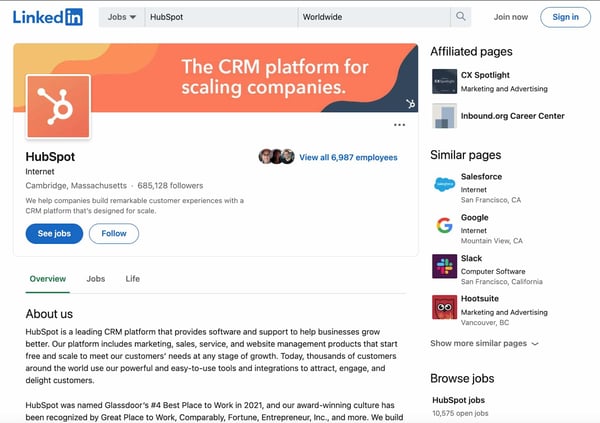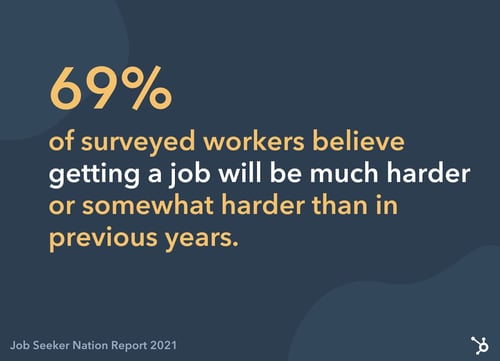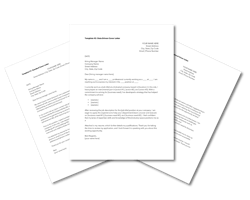Nowadays, companies have a computerized system that puts resumes through an online scanner which will automatically reject some applicants and push other applicants through depending on their qualifications.
So, What does this mean for you as a job seeker? Well, the cover letter attached to your application is more important than ever.
We've crafted this ultimate guide to cover letters. You'll find out how to write one that gets read, what to include, and browse tons of templates to gain inspiration.
You can dive straight in, or jump to the section you'd like to read.
Chapters
What is a cover letter?
A cover letter is a one-page document designed to persuade a hiring manager to interview you. It serves as a supplement to your resume and helps further explain why you’re a great fit for the job.
How long should a cover letter be?
OK, so you're all fired up and ready to craft the cover letter of the hiring manager's dream. But how do you manage the fine balance between in-depth and overwhelming?
A good cover letter is long enough to communicate why the recruiter should pick you but not long enough to bore them.
One page is usually enough to cover everything you'll need to include, without losing the recruiter's attention. Let's go into those items in more detail:
Your Name and Address
Kick-off your cover letter by adding your name and address to the document.
This step is pretty self-explanatory, but it allows the recruiter to easily connect your cover letter to your resume (especially if they're being printed).
Your name and address also make it easier for the recruiter to get in touch with a job offer. And that's the aim of our letter, right?
Their Name and Address
Similarly, you should add the name and address of the company or person you're writing to.
This shows you've done your research and allows the hiring manager to receive your letter if it's sent to a generic company email address.
The Date of Writing
Make it easier for the hiring manager to file your application by including the date on your cover letter.
Even if you're not successful this time around, the company might store your letter and refer back to it when they're hiring for another position.
Why You're Writing the Letter
We know that the aim of a cover letter is to persuade the hiring manager you're the best fit for their job.
Before you get to the good stuff, be sure to highlight the role you're applying for, as that can get lost.
Something like this will usually do the trick:
"I'm writing to discuss the content strategist role at HubSpot."
Why You're a Perfect Fit for the Job
The next section of a cover letter structure is the fun part. It's where you'll convince the hiring manager they should hire you.
In this section, answer these questions:
- Why should this company hire you?
- What skills do you have that will help complete the job better than anyone else?
- What makes you a good employee?
- What qualifications do you have that are relevant to the role?
Once you've answered these, the recruiter will have a solid understanding of who you are, and (hopefully) be convinced to bring you on for an interview.
What You Can Offer the Company
Have you ever heard the advice to "always sell yourself in a job application"? That concept can be applied to cover letters as well.
Businesses measure success in terms of results. The company looking for a new employee will want to know what they bring to the table and how you fit into their business goals. New candidates are rarely brought on board solely for the soft skills listed in their resume.
That's why this part of your cover letter structure is arguably the most important.
In two paragraphs or less, show the business what you can do — and provide examples of how you've done it before.
Not only does this give you the opportunity to show off your skills, but the company can picture the success you'll bring to their business by hiring you.
Your Availability
In the marketing world, we're always told the importance a call-to-action can make.
Great cover letters end with a brief section on the candidate's earliest start date.
How to Format a Cover Letter
How to Address a Cover Letter
Earlier, we mentioned the importance of addressing the hiring manager by their name and address. This proves you've done your research and ensures the cover letter lands in the right place.
Personalized letters will always outperform generic ones, so including the first name of the recruiter can go a long way.
But in a world where privacy is held close to our chest, you might need to do a bit of digging before finding the hiring manager's name.
Luckily, you can use the power of the internet to do this.
How to Find a Hiring Manager's Name
Head over to LinkedIn and find the company's profile page.
You can do this by entering their name into the search bar or searching for a link to their LinkedIn page on their company website.
Then, click the number of employees to see all employees who are on LinkedIn:

You'll then see a list of all employees along with their titles. Simply work your way through this list to find the most relevant contact.
Keep in mind that some employees do not have LinkedIn profiles, so you may not find them using this tactic. If you're unable to track down the hiring manager's name, a simple "Dear Hiring Manager" will work.
How to Open a Cover Letter
After you've addressed the cover letter to the most relevant person, you'll want to:
- Introduce yourself.
- List the role you're interested in.
- Explain your interest.
Here's an example:
"Dear Hiring Manager,
As an avid reader of the HubSpot Blog for the past five years, I am thrilled to submit my application for the content strategist role. I believe that my five years of experience working for B2B SaaS companies have equipped me with the skills needed to thrive in this role."
In the next two paragraphs, highlight your relevant experience and include key details from each role.
How to Close a Cover Letter
Once you've covered
Here are some great options:
- Looking forward to hearing from you
- Sincerely
- Best Regards
Then, sign the cover letter with your full name.
Should you include salary requirements?
The cover letter should focus on why you are a good fit for the role. Discussing salary requirements doesn’t fit at this stage of your application.
Instead, it’s best to wait until you speak to a recruiter or someone from HR to discuss your expectations.
Are cover letters necessary?
Today, in many industries, cover letters are listed as optional. The question is, should you include one if it's optional?
The answer isn’t exactly clear-cut.
Some research would suggest that cover letters may not hold the same weight as they once did. However, a cover letter can help you stand out among the competition.

In a 2021 Job Seeker Nation Report by JobVite, 69% of surveyed workers believed getting a job will be much harder or somewhat harder than in previous years. With this in mind, adding a cover letter to your application is a great way to stand out.
Writing a cover letter will allow you to:
- Communicate with the hiring manager.
- Rely on more than just bullet-pointed lists in your resume.
- Build your personal brand.
In short: Cover letters aren't absolutely necessary, but they do have stark advantages. If there's an option to upload one when applying for any job, do it — even if it's not required.
How to Write a Cover Letter
Writing a cover letter can be tricky. Even the best writers can struggle with communicating their skills in the right manner, but these tips will help you create a job-winning document.
The structure of your cover letter is arguably the most important thing about writing one.
Not only does a good structure help you to organize your points effectively, but it can help a hiring manager to quickly review the details you're sharing.
Featured Resource: 5 Free Cover Letter Templates

Download these free cover letter templates to write a stand-out cover letter.
7 Tips for Writing Great Cover Letters
So, you've crafted a cover letter and you're almost ready to hit send.
Before attaching to your resume and hoping for the best, use these seven tips to make sure your cover letter is as great as can be.
1. Keep it succinct.
Earlier, we mentioned how the best cover letters strike the perfect balance in their length.
Our best tip for writing cover letters is to avoid adding fluff that fails to add value. Every line should highlight why you're the best fit for the role.
In addition, cut the jargon and corporate-speak that hiring managers have heard before.
Yes, professionalism is important, but be harsh and critical when editing your cover letter. If a sentence doesn't add value, get rid of it.
2. Tailor it for the company and position you're applying for.
The one-size-fits-all approach doesn't fit well with cover letters.
You're applying for different roles at various companies, but don't let a change in name and address be the only updates you make.
Remember that a cover letter should explain why you should be hired for a specific role instead of anyone else. It's highly unlikely that multiple companies will hire for exactly the same position, so take some time to personalize your cover letter for every position you're applying for.
3. Don't repeat what's on your resume.
Although cover letters are submitted along with resumes, be wary of making them carbon copies of one another.
Instead, use the documents to compliment each other by:
- Including new skills.
- Elaborating on how your qualifications would help you in the role.
- Sharing how specific experience gives you an advantage over other candidates.
If you need to include the same thing in both documents, add "as listed in my resume …" rather than copy and pasting the same content.
4. Include data-backed examples.
When referencing experience from your resume, use your cover letter as an opportunity to explain in detail — with examples.
Examples allow the company to picture the success you could bring if they hired you, rather than the person next in their resume pile. But, data-backed examples give an extra edge.
Let's use an example. Which of these options is more impressive?
- I increased leads for the company.
- I increased leads by 35% in one month through a single blog post, which became the company's highest lead driver.
It's option B, right? That's because it's descriptive and shows results.
5. Tell a story.
Following on from the previous step, you could elaborate on your data-backed examples by telling a story.
Storytelling helps with relatability and gives a hint of your personality in a cover letter. It also makes the recruiter remember your cover letter amongst a sea of other one-page documents in their review pile.
However, this cover letter tip comes with a warning: Don't overdo it and make sure it's relevant.
6. Get a second pair of eyes on it.
Even the best writers make mistakes, but they can leave a negative first impression.
That's why our sixth cover letter tip is to get a second pair of eyes on it.
Email it to a friend or ask a family member to glance over it before you hit "send." Ask them to highlight any spelling mistakes or suggestions to improve how you're communicating with the person reading it.
You never get a second chance to make a first impression. Seeing as though a cover letter is one of the first documents a recruiter sees, try to make it perfect.
7. Be unique.
Finally, make your cover letter unique.
If you're applying for a creative role, experiment with colors, subheadings, and layouts.
If you're applying for more of a traditional role, be wary. Not everyone is a fan of bright, bold cover letters, but you can scope your limits by getting a feel of their company culture.
Are they strict and professional, or does the company like to have fun? (You can usually get a feel of this from their website or social media profiles.)
Testing the level of uniqueness can be a case of trial and error. If you're not getting great reactions from your cover letter, revise and try again.
Cover Letter Examples
We understand that inspiration can go a long way. That's why we've created a one-stop-shop for cover letter examples, which are available to view here.
You're also free to browse our collection of cover letter samples for extra inspiration on formatting your cover letter and learning from those who've helped to land dream jobs.
Now you're fully equipped to write a cover letter that will help you get your foot in the door.
Editor's note: This post was originally published in September 2018 and has been updated for comprehensiveness.


![→ Click here to access 5 free cover letter templates [Free Download]](https://no-cache.hubspot.com/cta/default/53/3f347702-d7e9-4e59-9fe4-be4cd7bad191.png)



![How to Write a Cover Letter for an Internship [Examples & Template]](https://blog.hubspot.com/hubfs/Copy%20of%20Featured%20Image%20Template%20Backgrounds-Aug-21-2023-02-03-52-3390-PM.png)
![Letter of Interest Tips, Templates & Examples [A 2023 Guide]](https://blog.hubspot.com/hubfs/letter%20of%20interest.png)

![How to Start a Cover Letter to Impress Employers [+ 14 Examples]](https://blog.hubspot.com/hubfs/how-to-start-a-cover-letter.jpg)

